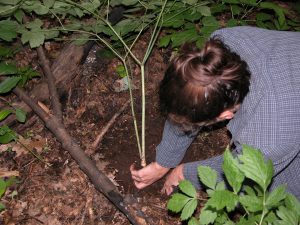
The roots of many forest plants are harvested for their medicinal values. Changes in climate and lack of management may imperil their long-term sustainability and the people who depend on them. Photo credit: James Chamberlain, USDA Forest Service.
The Forest Service of the U.S. Department of Agriculture has recently published “…the most comprehensive assessment covering the production and management of non-timber forest products (NTFPs) and resources – as well as the cultural, social, economic, and policy dynamics that affect them.” The assessment covers every state in the U.S.
But the findings can be utilized far beyond the U.S. borders.
“Every country that has non-timber forest products can take advantage of the findings in this report,” said Dr. James Chamberlain of the U.S. Forest Service and one of the report’s authors. He is also a Deputy Coordinator of the IUFRO Research Group on Non-wood forest products.
Sixty scientists and non-timber forest products experts across federal, state, tribal governments, non-governmental organizations, corporations, research institutions, and universities contributed to the report.
“Non-timber forest products are used for myriad purposes, providing cultural, social, and economic functions around the world. People harvest and use these products for food, medicine, arts and crafts, and religious and cultural rituals.
“They also harvest, trade, and sell NTFPs in local to global markets. This is a comprehensive report that can be used by other countries to help inform and shape policies that balance sustainable use and conservation of these natural resources, alongside ensuring benefits for harvesters and producers,” he said.
Think of edible fruits, nuts, berries, mushrooms, maple syrup and other saps, fuelwood, forage, wooden baskets, decorative wreaths, plant-based medicines and Christmas trees – that’s not an exhaustive list, but it gives an idea of just how ubiquitous non-timber forest products are.
In 2013, Dr. Chamberlain said, the Forest Service recognized the possibility that climate changes could affect these products and resources and initiated a national level comprehensive assessment of the effects and their implications.
The report finds that it is difficult to determine whether the trends or changes in ecological phenomena are the results of climatic variability or other factors.
However, the report states, NTFPs of the United States at the end of the 21st century may be significantly different than those of today due to changes resulting from stressors such as drought, fire, insects, disease and climatic variability.
It goes on to say that variability in temperature and in seasonality will alter the growing environment for plants and fungi harvested for non-timber forest products. This may reduce the range and abundance of some while increasing those for others.
Physical and phenological characteristics of plants and fungi will change in response to altered climatic conditions, which in turn affects their availability and suitability for use. (Phenology is the study of cyclic and seasonal natural phenomena – flowering, breeding, etc. – especially in relation to climatic conditions.)
Non-timber forest product species that occur in specialized habitats or climatic conditions likely will be more vulnerable to variability than those that grow across a range of conditions, the report notes.
Most models project that U.S. species habitat will move up in elevation or northward in latitude as suitability at lower elevations and latitudes declines. Populations of species that do not keep up with the pace of change will decline, be extirpated, or go extinct. Responses to climatic change along with harvest pressure may increase risk for some populations and species.
To give just two examples of potential changes foreseen in the report: loss of mangrove forest and arable land in Caribbean and Pacific coastal areas due to sea level rise; and decreasing habitat suitability for sugar maple and inconsistent temperature swings in the northeastern U.S., adversely affecting the production of maple syrup.
“Non-timber forest products need the same recognition that is given to other natural resources,” Dr. Chamberlain said. “We have to develop adaptive management strategies that conserve the resources and support the harvest of the products, along with public-private partnerships that reinforce this approach.
“As well, we should invest in accelerated research that will lead to knowledge sufficient to support active management and work with harvester communities to improve their understanding and incorporate local and traditional ecological knowledge.
“This report speaks specifically to the situation in the United States and shows us that non-timber forest products are significant to a large segment of our population. They are integral to our society and the many cultures that make up the nation,” he said. “They contribute significantly to local, regional, and national economies and require management similar to other natural resources, particularly timber.
“But other countries can use it to help inform and shape policies that balance sustainable use and conservation of their natural resources, alongside ensuring benefits for harvesters and producers,” Dr. Chamberlain said.
To Dr. Chamberlain, the key takeaway from the report is that NTFPs are important to the economy, to culture and to society and should receive the same understanding and management that exists for other forest resources.
The full report can be found at: https://doi.org/10.2737/SRS-GTR-232
For more information on the IUFRO Research Group, visit:
https://www.iufro.org/science/divisions/division-5/50000/51100/
View all IUFRO Spotlights at http://www.iufro.org/media/iufro-spotlights/

Leave a Reply